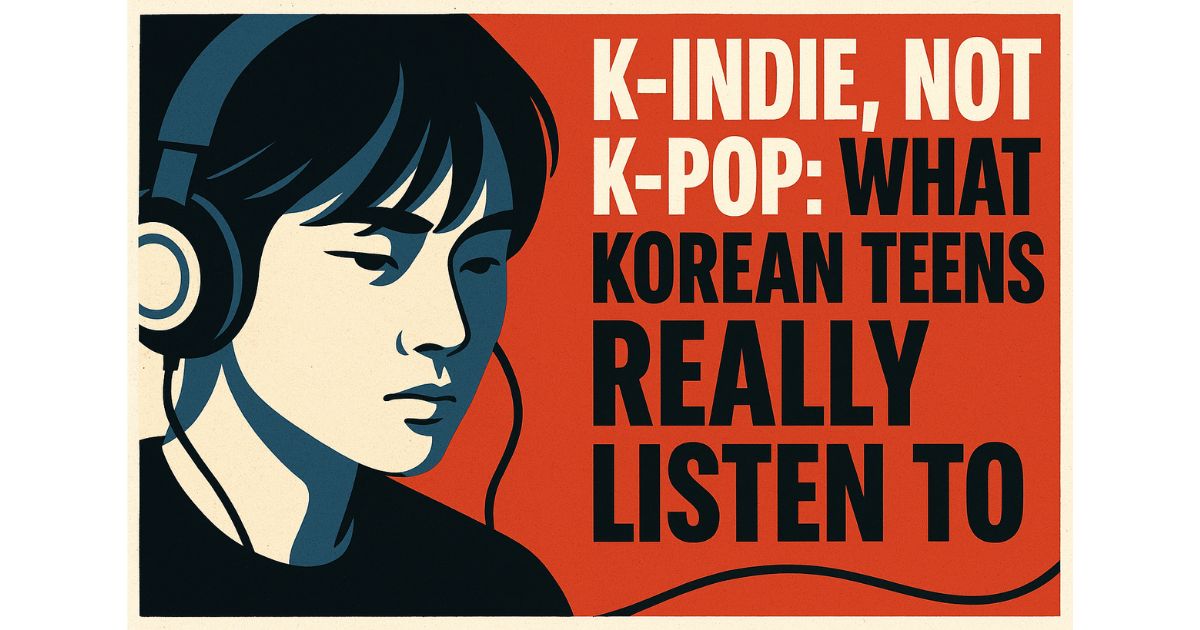Physical Address
5106 Whitman Way, Carlsbad, CA 92008
Physical Address
5106 Whitman Way, Carlsbad, CA 92008

Forget the choreographed perfection and viral fan cams — in the underground of Korea’s digital backstreets, a quieter, scrappier sound is playing through earbuds. And it’s not K-pop.
Beneath the global spectacle of K-pop’s glitz lies an entire generation of Korean teens who are tuning into something rawer. This isn’t rebellion for rebellion’s sake — it’s a search for something real. It’s late-night playlists on Naver’s Vibe, SoundCloud surf sessions, and self-recorded demos whispering through Bandcamp links in Instagram bios.
Welcome to the world of K-indie, where identity is fuzzy, genres bleed into one another, and teen taste isn’t dictated by algorithms, but by feelings.
“K-indie” is short for Korean independent music — a broad umbrella that covers everything from shoegaze to bedroom pop, from jazzy R&B to lo-fi synthwave. Unlike K-pop, which is label-sculpted and choreographed to perfection, K-indie artists often record in their bedrooms, produce their own music, and grow their fanbase organically through platforms like Melon, Bugs, and increasingly, YouTube Shorts.
While the term used to be limited to bands from the Hongdae scene (like Hyukoh and 10cm), today’s K-indie is genre-fluid and platform-native. It lives in digital pockets — and it’s spreading fast among teens seeking authenticity, intimacy, and sonic space.
📱 Algorithm fatigue: Teens feel overexposed to the same trending idol content on TikTok and YouTube. K-indie offers an escape from the mainstream attention economy.
🎧 Emotional intimacy: K-indie lyrics hit different — often raw, unfiltered, and hyper-relatable. Topics like academic burnout, loneliness, and self-identity are front and center, similar to what draws people to music for anxiety relief.
🎙️ DIY influence: The rise of platforms like BandLab and Soundtrap means more teens are making their own tracks — and they’re influenced by the music they find on indie platforms, not just music shows. Many start with online music learning tools or instrument tutorials.
👟 Fashion + Sound crossover: Indie artists often double as style icons in the vintage/alt scenes of Seoul, Gyeonggi, and Busan — a growing subculture where what you wear and what you listen to are part of the same aesthetic ecosystem.
Here’s who’s shaping the sound of Korean youth — with actual fan traction among teens in Korea:
| Artist | Style | Where Teens Listen |
|---|---|---|
| Wave to Earth | Lo-fi surf pop | YouTube, Naver Vibe |
| Meaningful Stone | Folk-pop with edge | SoundCloud, Instagram Reels |
| Se So Neon | Fuzzy psych-rock | Bugs, Bandcamp |
| ADOY | Dreamy synthpop | Spotify Korea, YouTube |
| Cheeze | Soft pop/R&B | Melon, IG Stories |
| Car, the Garden | Sadboi acoustic | Naver Vibe, TikTok |
| Luli Lee | Bass-heavy alt-pop | YouTube Shorts, SoundCloud |
| Jannabi | Retro, Beatles-esque | YouTube, fan cafes |
| BIBI (early work) | Gritty R&B | YouTube, underground playlists |
| Beenzino (indie crossover) | Lo-fi hip-hop | SoundCloud, Mixcloud |
Many of these artists get little to no promotion in the U.S., but rack up serious traction in Korean digital scenes — often through user-curated playlists and alt-genre Discords.
While the Hongdae indie scene used to be the heartbeat of K-indie, post-pandemic listening has decentralized the movement. Today’s indie energy pulses in:
It’s no longer about physical venues. It’s about presence across surfaces — and resonance with emotion-first listeners.
The future of global music isn’t just K-pop’s export engine — it’s the rise of genreless, DIY, emotionally nuanced music from every corner of youth culture. K-indie is Korea’s unique expression of that trend. And its growth is accelerating, both inside and outside the peninsula — in parallel with shifts in the most popular music genres worldwide.
In a world saturated by streams, likes, and polished personas, K-indie gives Korean teens — and the rest of us — a rare thing: a sound that feels human.
🔎 Platform to Watch:
Naver Vibe – Korea’s native streaming platform with indie-first playlist curation.
📚 Zine Watch:
Ton Plein – Korean-language zine covering K-indie shows, reviews, and micro-trend breakdowns.
🧵 Must-Follow Threads:
#Kindie #인디음악 #홍대음악 – Search these on Instagram and Twitter/X for teen-sourced discovery posts.
🎤 Live Streams Worth Catching:
Studio MOS, Seoul Busking Nights, and Indieground Korea on YouTube.